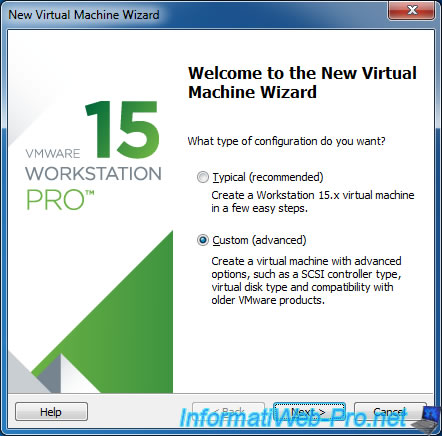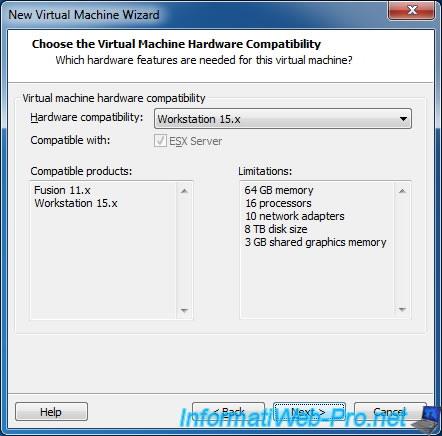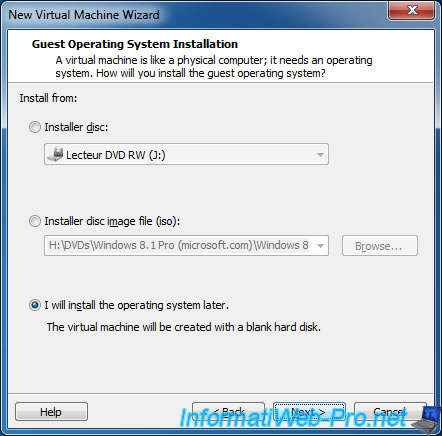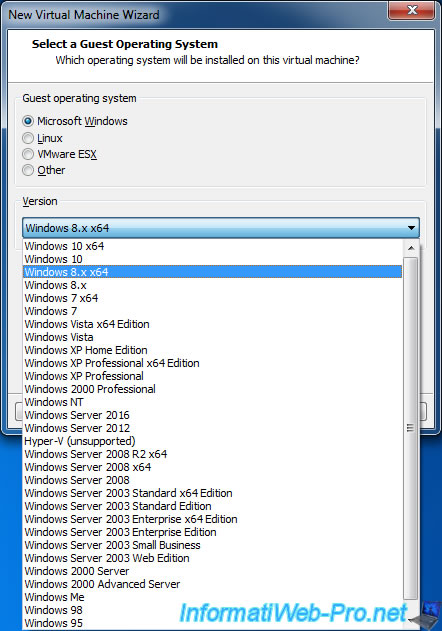Create a virtual machine and install it manually or automatically (Easy Install) with VMware Workstation 16 or 15
- VMware
- 31 January 2020 at 09:48 UTC
-

- 2/3
2. Manually create and install a virtual machine (Custom - advanced)
In our case, we always install our virtual machines manually to be able to configure them as best as possible when they are installed.
To do this, open the New Virtual Machine Wizard and choose : Custom (advanced).

By default, you will maintain the selected compatibility to get the best performance possible and to benefit from the new features offered by VMware (such as the Virtual Trusted Platform Module that allows you to better secure your virtual machines).
However, if you want to transfer it to another VMware program or use it with an older version of VMware Workstation, you may select another version.
Info : if you want to virtualize Windows 95 with VMware Workstation, you will have to use Workstation 5.x hardware compatibility as you will see in our tutorial : VMware Workstation / Player - Install Windows 95

To avoid using Easy Install, you will need to select : I will install the operating system later.

Since you didn't select the installation media for the OS you want to virtualize, VMware Workstation doesn't know which type of OS you will be virtualizing.
To provide the best performance and compatibility with the OS you want to virtualize, VMware will ask you :
- the type of operating system : Microsoft Windows, Linux, VMware ESX or other
- the Windows version you want to virtualize or the Linux distribution you want to install
Note that this list varies from version to version of VMware Workstation and is not complete.
In our case, we will select:
- guest operating system : Microsoft Windows
- version : Windows 8.x x64
Example : if you want to virtualize the Citrix XenServer virtualization server, you will need to find out that XenServer version 6.5 is based on the CentOS version 5 distribution.
Here, you will have to select "Linux / CentOS version 5 and earlier 64-bit".
Important : Mac OS X can't be virtualized with VMware Workstation, as this is prohibited by Apple.
Indeed, the Mac OS X operating system license is tied to hardware purchased from Apple. And since VMware Workstation is intended to run on Windows or Linux, this feature can't be implemented by VMware (although technically possible).
Since this is illegal, we don't cover this possibility on our site.
But, if you install VMware Fusion (which is the equivalent of VMware Workstation, but for Mac OS X) on an official Mac supported by Apple, you will be able to legally virtualize the 10.5 to 10.11 versions of Mac OS X.

Choose the location where you want to create your virtual machine.

Since Windows 8.1 supports UEFI and Secure Boot, you will have the choice between :
- BIOS : to use a classic BIOS and thus install Windows 8.1 in Legacy BIOS mode
- UEFI (+ Secure Boot) : to use UEFI firmware instead of the classic BIOS and install Windows 8.1 in UEFI mode. Note that the virtual hard disk will be initialized in GPT (GUID Partition Table) instead of the classic MBR (Master Boot Record). This can be a problem with some programs or Live CDs that are not compatible with UEFI and/or GPT.
In our case, we will keep the classic BIOS.

Select the number of processors and cores you want to assign to the virtual machine.

By default, VMware will select the recommended amount of RAM for the OS you want to virtualize.

By default, VMware uses NAT network access mode.

Depending on the OS that will be virtualized and its architecture (x86/x64), the controller for the hard disk may vary.
New since version 15.5 : you can use a Paravirtualized SCSI controller to increase compatibility with vSphere products.
Source : VMworld 2019: Fusion and Workstation Announcements

Depending on the virtualized OS, VMware will offer one or more types of hard drives.
Knowing that the SCSI is still very advantageous in virtual, because it allows you to add or remove virtual hard disks without stopping and restarting the virtual machine (= hot swap hard drives).

Create a new virtual hard disk.
Note that using a physical hard disk provides better performance for disk access, but it requires administrator rights and may pose a security problem since the machine is no longer isolated completely from the host system.

When you don't use Easy Install, you can :
- specify the maximum size of the virtual hard disk
- choose whether you want to allocate the space directly or not.
However, if the maximum size is large, the allocation may take a long time and the vmdk file will take the maximum size directly instead of the space actually used in the guest OS. - choose to store the contents of the virtual hard disk in one or more vmdk files.
Storing everything in one file gives you better performance, but slicing the hard disk file is useful if you want to be able to transfer your virtual machine more easily.

Specify a name for the virtual hard disk of your virtual machine.

Then, click on : Customize Hardware.

Since we didn't select the installation media at the beginning of the wizard, we need to configure the virtual CD/DVD drive to use the desired iso file.

Now, click on Finish.

Share this tutorial
To see also
-

VMware 3/16/2013
VMware Workstation - Boot a VM on the BIOS / EFI firmware
-

VMware 2/7/2020
VMware Workstation 15 - Installation on Linux
-

VMware 12/24/2021
VMware Workstation 15 - Slice the virtual hard disk of a VM
-

VMware 12/10/2021
VMware Workstation 15.5 - Convert a Virtual PC virtual machine to a VMware VM

No comment